|
In
recent years, shooters searching for a pure-form Single Action
Army revolver are confronted with several options and their
attendant compromises and complications. The potential buyer must choose among the mechanically and
cosmetically evolved third generation Colts, increasingly
expensive first and second- generation revolvers or the plethora
of Italian replicas.
It
was early 2003 and I had been shooting a number of original
Colts belonging to shooting partner, Johnny Bates.
I was inclined to start looking for my own second
generation Colt when a conversation with premier revolversmith, Hamilton
Bowen, changed the equation entirely.
Bowen had been using the USFA revolvers as a
favored basis for his custom single actions, replacing the
Italian lock work with domestic parts. Now, not only are the
frames and barrels produced domestically, but the company has
abandoned the brittle action parts in favor of high quality
American components. Current examples Bowen had examined
exhibited perfect fit, finish and timing as well as careful
attention to barrel/chamber measurements. Bowen summed it up in
this wise: “There
is really nothing that needs to be done to them.”
This
tipped me over the edge and I called Geno Paesano at United
States Firearms. All
USFA products except the basic CAS
Rodeo Revolver are built to order with an expectation of
delivery in about 12 weeks.
Mine
would have the “civilian” 4 ¾” barrel length Single
Action Army with the “Pre War” finish.
I debated ordering the revolver in .44 Special but
settled on .45 Colt. It
is a pleasant shooting round in its standard loading and is the
cartridge most associated with this revolver.
The Pre War model is so named to evoke the period between
1920 and 1940 when the first generation single actions reached
the apex of fit and finish.
Paesano told me that the revolvers are fired and
regulated at 12 and 25 yards and that the standard trigger pull
ranges from 3.5 to 4 pounds.
These specifications and overall performance are
identical to those of the less expensive Rodeo model.
The color case hardening and “armory blue” are
applied by Turnbull Restorations.
The
order was finalized on June 9, 2003 and completed on September
16. Unboxed and
removed from its velvet sock, it caused a general intake of
breath at Leo Bradshaw’s GunRoom.
The overall metal work was nothing short of perfection
and the color casehardened frame, gate and hammer showed a
brilliant pattern from all aspects.
Leo, a noted dealer in collectibles, pronounced the
carbon blue to be true to the Colts of the late 19th
Century.
The
trigger pull weighed in at 3 pounds 12 ounces to 4 Pounds on my RCBS
trigger pull gauge and a Houston Cartridge Co. 250 grain
Round Nose Flat point measured exactly .452” after I tapped it
through one of the chambers.
Timing/carry-up is perfect with the bolt dropping
precisely in the lead of the cylinder notches. The cylinder
exhibits no end float or lateral play.
Six
five-round groups with two different loads averaged out at
2.55” from the bench at 25 yards.
This corresponds to some recently published ransom rest
groups from a USFA Rodeo. The
two loads, separated by 50 feet per second in velocity, hit
exactly to my point of aim; unusual for a fixed sighted
revolver, and evidence that the factory sight regulator knows
and cares what he is about.
| Load |
Velocity / Energy |
Spread (10 Rounds) |
Standard Deviation |
| 7.5 Unique, 250 RNFP |
814 / 368 |
41 |
13 |
| 8.0 Unique, 250 RNFP |
878 / 428 |
36 |
13 (12.5) |
| 8.0 Unique, Dry Creek 265 KT |
882 / 458 |
2 (5 rounds) |
2 (1.6) |
| 8.5 Unique, 250 RNFP |
930 / 480 |
80 |
24 |
| PMC 250 CAS (Factory Load) |
781 / 339 |
68 |
19 |
My
hand loads are traditional in nature; the goal being to
duplicate expected .45 Colt performance with economical and
readily available components. Eight grains of Unique and the
machine cast 250 grain RNFP bullet seems to be optimal in this
respect though none of my loads varied much in demonstrated
accuracy or point of impact.
The
aspect of revolver shooting that gives me the warm fuzzys is
hitting reasonably well from the traditional “NRA”,
“Duelist” or “ Off-hand” stance My early best
effort five round string at fifty feet printed 2.4” with the
best 4 in about one inch. My
worst efforts will go un-remarked but after I had made some
progress with trigger control, I shot a couple of reasonably
nice consecutive targets at 25 yards. The first landed 6 rounds
in 2.7” wide by 4” tall.
Emboldened, I invested ten rounds in a target that came
out 3.7” tall by 5.6” wide.
The
USFA Pre War's handling characteristics are indistinguishable
from first and second generation Colts, and the trigger pull
seems to be in the middle range of those encountered in the
originals. The sights of course, are of the Twentieth Century
pattern - wider and a bit easier to use than the old narrow
blade and notch used before about 1920. Cylinder diameter and
chamber wall thickness is minimally larger than three
generations of Colt and exactly the same as an Uberti .45
we had on hand. Nevertheless,
the cylinder from a .45 Colt made in 1910 fit and functioned
very well, displaying very little end-float and a slightly wider
cylinder gap. The grips are hard rubber serially numbered and
bearing the trademark “US” cartouche. We found that Colt
grips matched the frame exactly except for the location of the
retaining pin hole.
The
United States Firearms Single Action Army, American made in the
old Colt factory at Hartford, is a near-perfect rendition of the
traditional Peacemaker. The reviewer would have to go far afield
to find any aspect of the item to criticize.
The only complaints to emerge are that the revolver lacks
a rampant pony on the grips and the left side of the frame and
that it is very likely better than the original.
For information about the full product line, custom work and
engraving visit the United States Firearms site at: ww.usfirearms.com.
The
Gunblast article by Jeff Quinn on the USFA
Rodeo is recommended, and for an excellent pictorial
overview of the Single Action Army Revolvers, the author
recommends Classic
Colt Peacemakers
by “Doc” O'Meara.
Mike
Cumpston
(Ed.
Note: We are pleased to welcome our friend Mike Cumpston to
the Gunblast.com team. Read more about Mike on the About
Us Page.
Boge
Quinn)
NOTE: All load data posted on this
web site are for educational purposes only. Neither the author nor
GunBlast.com assume any responsibility for the use or misuse of this data.
The data indicated were arrived at using specialized equipment under
conditions not necessarily comparable to those encountered by the
potential user of this data. Always use data from respected loading
manuals and begin working up loads at least 10% below the loads indicated
in the source manual.
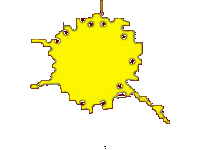  
Got something to say about this article? Want to agree (or
disagree) with it? Click the following link to go to the GUNBlast Feedback Page.
All content © 2003 GunBlast.com.
All rights reserved. |
|
Click pictures for a larger version.
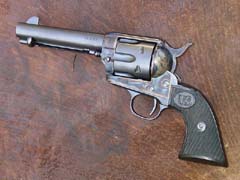
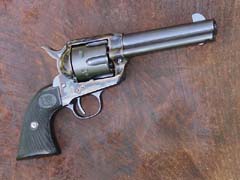
USFA's "Pre War" Single Action Army is an
exquisitely-executed reproduction of the classic Colt SAA.
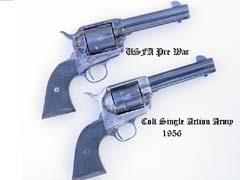
USFA's Pre War SAA is all but indistinguishable from the
venerable (and expensive) Second Generation Colt.
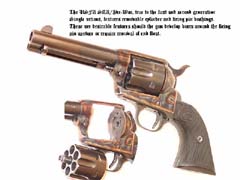
The USFA Pre War, true to the First and Second
Generation SAAs, features removable cylinder and firing pin
bushings. These are desirable features should the gun develop
burrs around the firing pin aperture or require removal of end
float.
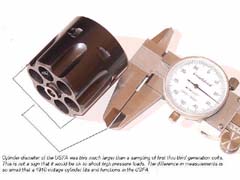
Cylinder diameter of the USFA Pre War was slightly
larger than First through Third Generation Colts. This is NOT
a sign that that it is OK to shoot higher-pressure loads in
the USFA Pre War. The difference in measurements is so small
that a 1910 vintage cylinder fits and functions in the USFA
gun.
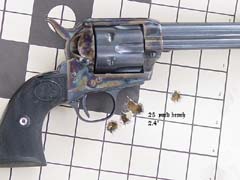
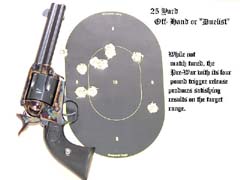
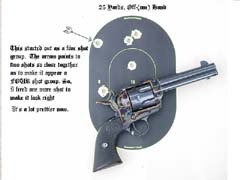
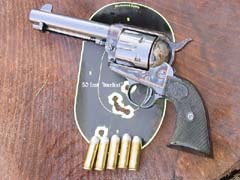
The USFA Pre War is capable of good accuracy, as can be
seen in these photos.
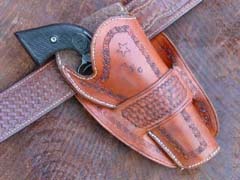
Author's favorite holster for the Pre War SAA is this Johnny
Bates fleece-lined unit.
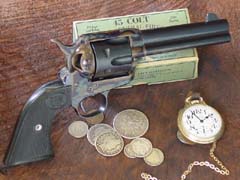
The USFA Pre War Single Action Army is a near-perfect
reproduction of the original Colt. If anything, it is better
than the original!
Pocket the several thousand dollars' difference in price
and enjoy shooting one of these fine examples of the gun
maker's art.
|
![]()